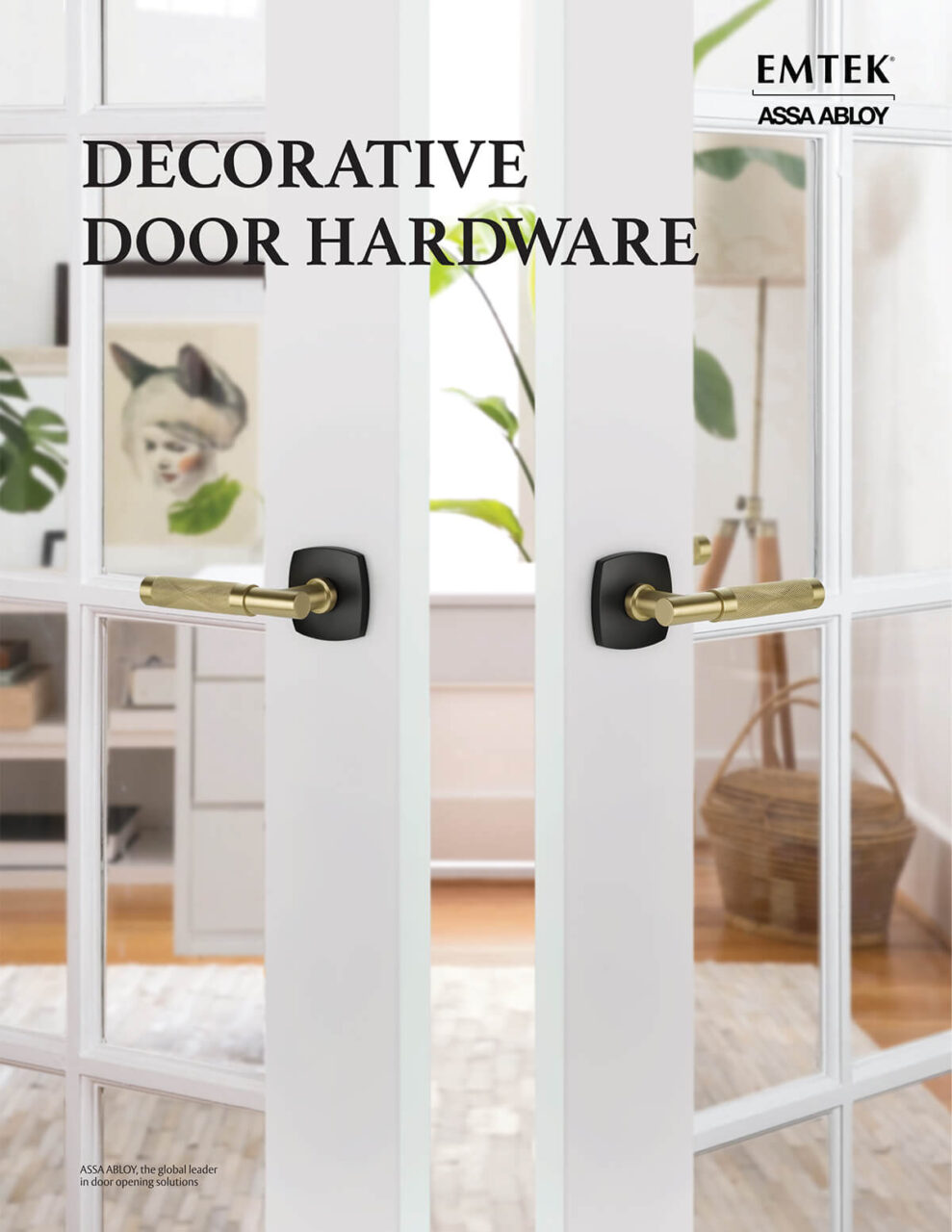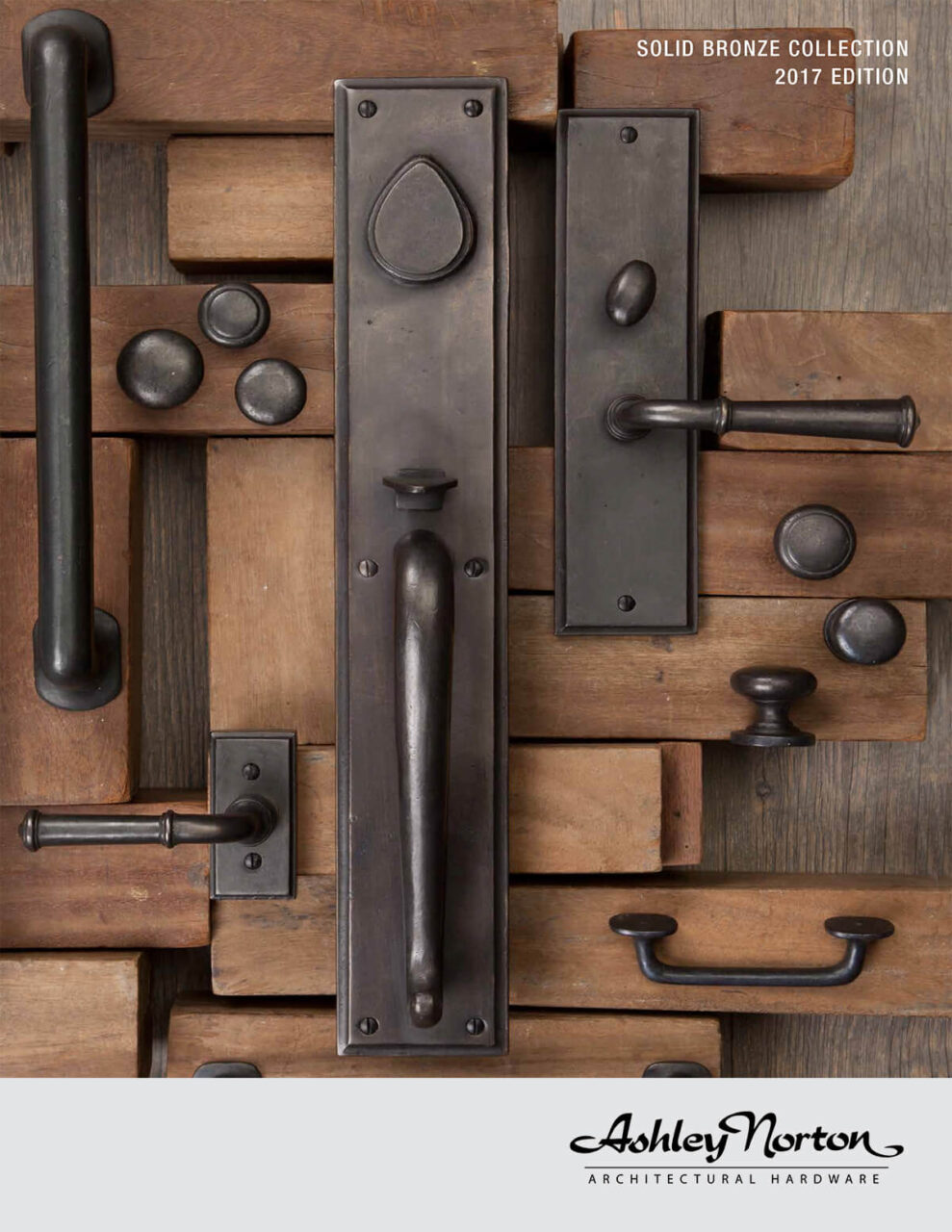Locksets
Sun Mountain distributes locksets from Rocky Mountain Hardware®, Ashley Norton, Emtek®, and other leading suppliers. Three basic types of locksets are available—handles, knobs, and levers. All levers must be specified for handing. Handles are often combined with knobs or levers on the inside of the door, and these combinations are called “handlesets.” Numerous styles are available to match the design of every home and hardware suppliers typically present lockset collections by architectural style, such as Traditional, Craftsman, Modern, and Rustic.



INTERIOR LOCKSETS
Interior handles, knobs, and levers are available with two types of mechanisms—spring latch (or cylindrical) and mortise case. The majority of interior door locksets sold in the U.S. are spring latch. Interior mortise case sets are more expensive and can be found in the highest-end homes.
Interior locksets are further divided into four functions:
- Dummy sets have inoperable knobs or levers on one or both sides of the door, and are typically used in double door units in conjunction with ball or roller catches, or flush bolts.
- Passage sets are non-locking with operable handles, knobs, or levers. They are typically used on doors that do not require security or privacy, such as closets, laundry or utility rooms, pantry, or mechanical rooms.
- Privacy sets have operable handles, knobs, or levers but can be locked by a push button or thumb turn on the interior side of the door. They can be unlocked by an emergency release key from the exterior side. Privacy locksets are typically used on bedroom and bathroom doors.
- Entry locksets are like privacy hardware, but are keyed on one side of the door. Any handle, knob, or lever with a key lock is called entry hardware. Entry hardware must be specified for handing. Deadbolts are often included with entry locksets.
EXTERIOR LOCKSETS
Exterior locksets are entry sets, often with deadbolts, and are available with three types of mechanisms—spring latch (or cylindrical), mortise case (also called “mortise lock”), and multi-point.
- With the spring latch lock, the door handle (the handle, knob, or lever) is separate from the deadbolt cylinder and requires entry via a key inserted into both the deadbolt and the keyed handle.
- A more elegant and secure type of lockset is the mortise case, typically found in higher-end homes. This mechanism integrates both the latching and deadbolt mechanisms into a single cartridge-style lock, encased in a metal box and protected by a metal plate where the latch and deadbolt protrude. The cartridge is inserted in a “mortise” or hole cut into the door edge, and both the latch and deadbolt are operated by a single key. Typically a metal strike plate the full height of the cartridge (called the “box keep”) is mounted on the strike side jamb, to receive both the latch and deadbolt. The metal plate and box, and the large strike plate, provide security against prying on the door edge. Mortise case locks also feature a special interior emergency release that allows operation of the latch and deadbolt simultaneously from inside the home, in the event of a fire or other emergency.
- Multi-point locks contain a mechanism that latches the door at several points over the height of the door, instead of only at a single point near the handle. Multi-point locks are recommended for very tall (8′ 0″ or 96″ and over) exterior doors, especially for double doors. Sun Mountain distributes Trilennium™ multi-point locks from Endura®, with a choice of entry handlesets from suppliers such as Rocky Mountain Hardware® and Emtek®. An additional fee is charged to mortise the door edge and jamb for the multi-point system.
TYPES OF METAL
Door handles, knobs, and levers are most commonly manufactured in three metal materials:
- Steel is less common in the production of handles, knobs, and levers than either bronze or brass. However, steel is an excellent material for a weathered, rustic appearance, when the hardware will not be exposed to outside elements. When exposed to the elements without a protective coating, steel will rust and deteriorate quickly. For this reason, steel locksets are often powder-coated for protection.
- Bronze is typically offered in two finishes—silicon bronze (an alloy of copper, silicon, and zinc), and white bronze (an alloy of copper, manganese, nickel, and zinc). Bronze will oxidize over time, changing color, sheen, and texture. This “living finish” is referred to as the patina. No cleaner, wax, or polish can stop the oxidation process, but a high-quality clear floor wax can protect the finish. Change in bronze patina is not covered under warranty by any manufacturer, except for a few companies that offer a “lifetime” finish.
- Brass is also a common metal used in the production of handles, knobs, and levers. Brass is an alloy of copper and zinc. After production, it is generally coated with a lacquer finish to prevent tarnishing. The lacquer coating can preserve the bright finish of the metal for up to several years when the hardware is exposed to outside elements, and indefinitely when positioned indoors. After the lacquer has deteriorated, it is recommended that the lacquer be removed and the hardware be regularly polished to maintain a bright finish. Un-lacquered brass will weather more attractively than brass with deteriorated lacquer. When freshly polished (and un-lacquered), brass is similar to gold in appearance, but becomes a reddish color with ongoing exposure to the outside elements.
Current catalogs for Sun Mountain’s primary lockset suppliers are shown here (click to view or download). Contact Sun Mountain at 888.786.6861 or sales@sunmountaindoor.com to request a free, no-obligation quote. As a preferred distributor, Sun Mountain offers significant discounts off list prices.



